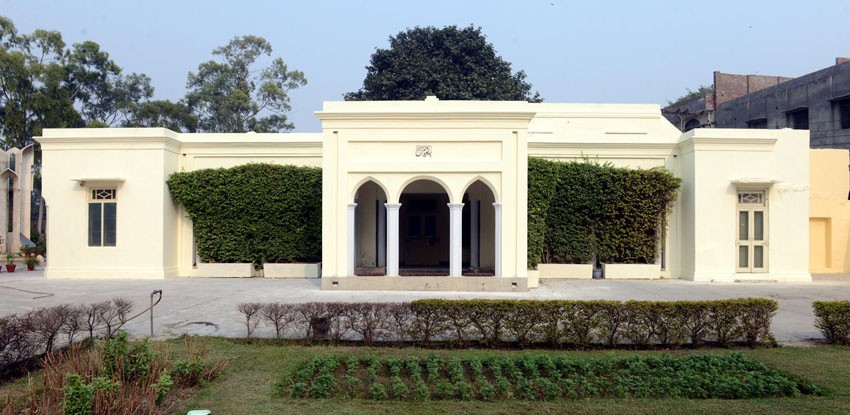
Renovation work has started on Allama Iqbal Museum in Lahore, drawing attention to so many issues

Whenever there is a media report about repairs to a building of some historical import, the heart sinks because it means intervention and reconstruction on a grander scale than required. Many in the corridors of power, ashamed of the old and rickety, consider all that is ancient as a sign of being poor and backward, and are ever waiting to go on a renovation crusade to make antiquity appear new and shimmering.
Iqbal’s house on the erstwhile Mayo Road, now aptly called Allama Iqbal Road, is not that old. It was constructed by him in the last few years of his life; the only house that he owned and named Javed Manzil after his son Javed Iqbal. He also breathed his last in the same house. The government announced its plans to convert the place into a museum in 1961 in order to preserve Iqbal’s possessions and display his celebrated works -- the museum contains handwritten drafts of his works, photographs, certificates, awards, medals and educational degrees. The government purchased the residence from Javed Iqbal who also donated six hundred objects belonging to Muhammad Iqbal to the museum. The museum has a library and nine galleries and was renovated in December 1984. Since house museums are supposed to look the way they were when the original owner or occupant of the house lived there, it has been kept in the same state as it was when the poet lived there.
Very few understand the difference between renovation, conservation and restoration. Old buildings and sites are supposed to be restored and conserved, not renovated or built anew. The prevalent concept is to make the intervention so blatant that it appears to look new or at least not old except for the dates in the archeological manuals. Massive renovation work was done at the Shalimar Gardens and the Lahore Fort that almost ruined the original structure and its very sophisticated overlay.
One reason why there is so much emphasis on renovation is because the craft and the art of the era when these building were designed and constructed is not available any more. In order to shield the lack of expertise, repairs and construction work is done in accordance with current practices, technical knowledge and know-how. The temples at Katasraj, the second most sacred site for the Hindus, too, have been rebuilt to devastating effect; it seems now that Shiv and Sati, as if the progeny of the nouveau riche, lived in present times.
Iqbal spent a considerable part of his life in Lahore. The place where he was born is now called Iqbal Manzil in Sialkot and then the room where he stayed as a boarder in the Quadrangle, in Government College Lahore, has also recently been identified. The Quadrangle is now called Iqbal Hostel where the freshmen to the college reside; the New Hostel, probably built in 1926 is meant for the graduate and post graduate students. He lived in Lahore’s Bazaar Hakeemaan, Bhatti Gate and then moved on to McLeod Road but it appears that his residences have either not been identified or have been lost to history. What is left is this house on Mayo Road (now called Allama Iqbal Road).
When the Museum was visited a couple of days earlier, it was closed to the public while plenty of construction material was strewn its ample lawns. One was told that, primarily, the sums have been allocated to get the roof repaired because it was sagging and becoming hazardous; especially in monsoon, a lot of effort was required to save the artifacts of the Museum which is not visited that much and is a sleepy place.
While great emphasis has been placed on the study of Iqbal since the beginning, efforts in this regard have mostly been half-hearted. The decision to set up Iqbal Academy (1951) further streamlined by Iqbal Academy Ordinance (1962) should be seen in this context. The Academy has had an indifferent run -- it was almost non-functional, except, perhaps holding of an occasional seminar and publishing a book. However, in 1984, it was revitalised yet again by a new charter with a full time director, academic staff and sufficient funds.
Parallel to this organisation, the idea of Aiwan-e-Iqbal was mooted at the centenary celebrations of Iqbal (1975-76) and an Aiwan-e-Iqbal Authority was initially housed in this very residence of Iqbal on Allama Iqbal Road but then was shifted to the Free Masons Lodge on the Mall. Later, it was decided that the prestigious body should have its own dedicated space and in 1984 construction actually did start by the federal government on the land donated by the Punjab Government on Egerton Road behind the Alhamra. It was completed and merged with the Iqbal Academy in 1997 but the merger did not have a proper constitutional cover through an act of parliament.
One is not clear as to what is the relationship between all these bodies but the recurring impression is that all these bodies under-perform either because of financial constraints or organisational dysfunction. It can be said with great deal of certainty that very few visitors go to the Iqbal Museum; perhaps some stray scholar in need of evidence drops by to make use of the things there. A case can be made for making the place a living, thriving institution with exhibitions, lectures, seminars, book launches, and discussions held on topics that are relevant and not wholly related to Iqbal in the narrower sense. This could push the place into making an optimum use of facilities; otherwise it will stay sleepy and underused -- with only repairs every now and then making it newsworthy.